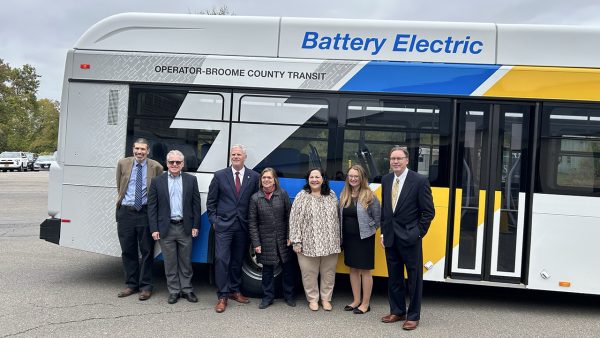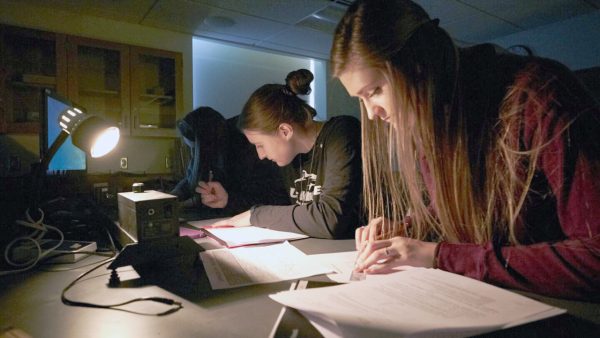Get our email updates
Stay up-to-date on the companies, people and issues that impact businesses in Syracuse, Central New York and beyond.
What's New
Upcoming Events
CNYBJ Job Board

Broome County’s first fully electric buses start transporting the public
VESTAL — Broome County Transit’s first fully electric buses have been transporting the public for nearly two months after they were placed into service in mid-October. The new zero-emission buses replace older diesel models, “significantly improving” air quality and reducing greenhouse-gas emissions across the community, Broome County said in its announcement. The electric buses are […]
Get Instant Access to This Article
Become a Central New York Business Journal subscriber and get immediate access to all of our subscriber-only content and much more.
- Critical Central New York business news and analysis updated daily.
- Immediate access to all subscriber-only content on our website.
- Get a year’s worth of the Print Edition of The Central New York Business Journal.
- Special Feature Publications such as the Book of Lists and Revitalize Greater Binghamton, Mohawk Valley, and Syracuse Magazines
Click here to purchase a paywall bypass link for this article.
VESTAL — Broome County Transit’s first fully electric buses have been transporting the public for nearly two months after they were placed into service in mid-October.
The new zero-emission buses replace older diesel models, “significantly improving” air quality and reducing greenhouse-gas emissions across the community, Broome County said in its announcement. The electric buses are also quieter, “creating a smoother and more comfortable ride for passengers while minimizing noise pollution in residential neighborhoods.”
Broome County Executive Jason Garnar, BC Transit Commissioner Greg Kilmer, and Marie Therese Dominguez, commissioner of the New York State Department of Transportation (NYSDOT), gathered for the event announcing the deployment of the electric buses. Broome County sees it as a “major milestone in the county’s efforts to modernize its public transportation system, reduce emissions, and strengthen sustainability,” per its Oct. 14 announcement.
Federal and state grants primarily paid for the six new 40-foot GILLIG battery-electric buses, with nearly 95 percent of the $10.4 million total project cost supported by outside funding sources, Broome County stipulated.
The project received $3.25 million through the Federal Transit Administration’s Low or No Emission Vehicle program, $4.3 million in federal formula funding, $1.54 million from the New York State Truck Voucher Inventive program, and $754,000 in state capital funding.
Broome County contributed just over $540,000, representing only about 5 percent of the total project cost, the county stated.
“Broome County depends on BC Transit to connect our residents to work, school and essential services every day,” Garnar said in the Broome County announcement. “This investment allows us to modernize our fleet while protecting taxpayers. Nearly 95% of this project was funded through state and federal grants, helping us bring cleaner, quieter, and more reliable transit to the people of Broome County.”
To support the new fleet, BC Transit has installed six Heliox/Siemens 180 kW chargers featuring a retractable arm system that keeps charging cables safely overhead inside the transit depot. Charging-infrastructure design and construction was led by PlugIn Stations Online, with site management by the New York Power Authority. Additional plans call for solar panels and on-site battery storage at the Vestal Transit Center by 2027, ensuring service continuity and energy resiliency, Broome County noted.
“These six buses represent the first step in the process of moving to clean air propulsion with seven more buses to come in 2026,” Greg Kilmer, commissioner of BC Transit, said. “This exciting moment is made possible by many talented and dedicated individuals who had the vision to legislate, fund, design and build the future of public transportation. I’m certain all the residents of Broome County will appreciate the clean, quiet and efficient operation as we serve thousands of riders daily.”
The six buses, built in California this summer, arrived in Broome County in August after being driven cross-country along a network of electric-vehicle charging stations.
BC Transit provides more than 2 million rides annually and operates up to 18 hours each day. Students, faculty, and staff at Binghamton University and SUNY Broome Community College ride BC Transit free with their university-issued IDs.

Finger Lakes Land Trust acquires land in Spafford
SPAFFORD — The Finger Lakes Land Trust (FLLT) earlier this year acquired 850 feet of shoreline and 15 forested acres along the eastern shore of Skaneateles Lake in the town of Spafford in southern Onondaga County. The property includes 1,120 feet of streambank on Barber Gulf and a portion of the Staghorn Cliffs, the site
Get Instant Access to This Article
Become a Central New York Business Journal subscriber and get immediate access to all of our subscriber-only content and much more.
- Critical Central New York business news and analysis updated daily.
- Immediate access to all subscriber-only content on our website.
- Get a year’s worth of the Print Edition of The Central New York Business Journal.
- Special Feature Publications such as the Book of Lists and Revitalize Greater Binghamton, Mohawk Valley, and Syracuse Magazines
Click here to purchase a paywall bypass link for this article.
SPAFFORD — The Finger Lakes Land Trust (FLLT) earlier this year acquired 850 feet of shoreline and 15 forested acres along the eastern shore of Skaneateles Lake in the town of Spafford in southern Onondaga County.
The property includes 1,120 feet of streambank on Barber Gulf and a portion of the Staghorn Cliffs, the site of an ancient, fossilized coral reef, the FLLT said.
Located near the south end of Skaneateles Lake, this acquisition will extend the FLLT’s protected shoreline to 3,000 feet in this area, preserving the staghorn coral fossils as well as habitat for bald eagles and other wildlife.
The property is adjacent to the organization’s 90-acre Staghorn Cliffs Preserve and 21-acre Cora Kampfe Dickinson Conservation Area, which together “encompass some of the most pristine shoreline remaining in the Finger Lakes region,” FLLT contends.
Due to the hazardous nature of the steep hillsides above the cliffs, FLLT will own and manage the property as a nature preserve accessible by canoe or kayak. Protection of this property will “safeguard” wildlife habitat and the water quality of Skaneateles Lake by preventing development on its forested hillsides, the Ithaca–based organization noted.
The acquisition was made possible by an internal loan from the FLLT’s Opportunity Fund. The land trust is now launching a fundraising campaign to raise $1.1 million to cover the cost of the purchase as well as the long-term management of the site.
The property was identified as a priority for protection as part of the FLLT’s effort to create a greenbelt around the south end of Skaneateles Lake. Other nearby conservation lands include the High Vista and Hinchcliff Family preserves. The greenbelt is recognized as a priority project within New York State’s Open Space Plan and, because of its value for migratory birds, it is also recognized by National Audubon as one of the state’s Important Bird Areas, FLLT said.
Completion of this acquisition will also help ensure water quality within Skaneateles Lake, which is the unfiltered drinking-water supply for 220,000 area residents, including people living in the city of Syracuse.
“The quality of our lakes depends on the condition of the landscapes that surround them,” Andrew Zepp, president of FLLT, said in the announcement. “This acquisition will secure steep slopes and sensitive shoreline areas that would lead to increased erosion and runoff if they were developed.”
About the Finger Lakes Land Trust
The FLLT says it focuses on protecting critical habitat for fish and wildlife, conserving lands that are important for water quality, connecting existing conservation lands, and keeping prime farmland in agriculture. The organization also provides programs to educate local governments, landowners, and residents about conservation and the region’s unique natural resources.
By working cooperatively with landowners and local communities, the Finger Lakes Land Trust says it has protected more than 34,000 acres of the region’s undeveloped lakeshore, rugged gorges, rolling forest, and scenic farmland. The FLLT owns and manages a network of more than 45 nature preserves that are open to the public and holds perpetual conservation easements on 200 properties that remain in private ownership.

Hancock Estabrook, LLP announced that Ashley D. Hayes has rejoined the firm’s Litigation, Labor & Employment and Intellectual Property departments. She rejoins the firm after

CBRE Upstate has welcomed Eddie Kirshner to its team. He brings experience in investment sales, leasing, underwriting, and financial analysis across the Binghamton and upstate

CBRE Upstate has welcomed Amie Culver to its team. She brings strong experience in commercial acquisitions, dispositions, market analysis, and client relationship management. Culver has

With Micron in mind, Le Moyne to offer new physics major in 2026
SYRACUSE — Micron Technology, Inc. (NASDAQ: MU) has plans to build a massive semiconductor-manufacturing campus in the town of Clay, and Le Moyne College wants to help prepare future students to secure a job with the Boise, Idaho–based company. The school is set to offer a bachelor’s degree in applied physics “as the region prepares
Get Instant Access to This Article
Become a Central New York Business Journal subscriber and get immediate access to all of our subscriber-only content and much more.
- Critical Central New York business news and analysis updated daily.
- Immediate access to all subscriber-only content on our website.
- Get a year’s worth of the Print Edition of The Central New York Business Journal.
- Special Feature Publications such as the Book of Lists and Revitalize Greater Binghamton, Mohawk Valley, and Syracuse Magazines
Click here to purchase a paywall bypass link for this article.
SYRACUSE — Micron Technology, Inc. (NASDAQ: MU) has plans to build a massive semiconductor-manufacturing campus in the town of Clay, and Le Moyne College wants to help prepare future students to secure a job with the Boise, Idaho–based company.
The school is set to offer a bachelor’s degree in applied physics “as the region prepares for the arrival of Micron Technology within the next several years.”
The New York State Department of Education approved Le Moyne’s request to offer the degree program, the school said in a Nov. 21 announcement. It’ll be available for new and current students starting with the 2026 fall semester.
The new major “unlocks the physical principles behind modern breakthroughs” such as semiconductors, sensors, renewable-energy systems, and other technological advances, preparing students to work in fields that are expected to “grow significantly” over the next 10 years.
“Le Moyne is excited to offer the new applied physics major, which will strengthen Le Moyne’s position as a key player in emerging careers in engineering, as well as specific fields such as semiconductors and material sciences,” Le Moyne College President Linda LeMura said in the school’s announcement. “Building from a foundation in liberal arts and sciences provided by our core curriculum, the program was created to meet the anticipated employment growth and a strong student interest within the region and across the state.”
These careers could include positions at the Micron facilities that will be built in the town of Clay. With an investment of up to $100 billion over the next 20 years, the firm estimates the fabrication (fab) plants could eventually result in 9,000 jobs at Micron and 9,500 jobs in businesses that supply Micron.
Le Moyne cites both state and federal labor statistics as indicating job growth in areas such as electrical engineering and materials science are anticipated to grow between 6 percent and 7 percent through 2034, higher than the average for all occupations.
The industries that will be hiring individuals with applied physics degrees include semiconductor and microelectronics (e.g., chip manufacturers, fabs); advanced manufacturing and materials; aerospace and defense; medical imaging and diagnostic sonographers; energy and renewable technology; software developer (instrumentation, embedded systems); government and national labs; and analytics and quantitative finance, per the Le Moyne announcement.
“Applied physics has been described as where scientific curiosity meets hands-on innovation,” Christopher Bass, chair of Le Moyne’s physics department, said. “Applied physics fully embraces Le Moyne’s educational mission by incorporating ethical scientific conduct and inquiry into the curriculum. The program will offer personalized mentoring, advanced labs and research opportunities where students will gain the knowledge and experience that will allow them to step confidently into high-demand careers.”
SUNY Sustainability Fellows include area professors
ALBANY — Three Central New York college professors and one from the Southern Tier are among 11 of SUNY’s inaugural Sustainability Faculty Fellows. They include Jean Yang, assistant professor of landscape architecture at the SUNY College of Environmental Science and Forestry in Syracuse; Augusta Williams, assistant professor of public health at Upstate Medical University in
Get Instant Access to This Article
Become a Central New York Business Journal subscriber and get immediate access to all of our subscriber-only content and much more.
- Critical Central New York business news and analysis updated daily.
- Immediate access to all subscriber-only content on our website.
- Get a year’s worth of the Print Edition of The Central New York Business Journal.
- Special Feature Publications such as the Book of Lists and Revitalize Greater Binghamton, Mohawk Valley, and Syracuse Magazines
Click here to purchase a paywall bypass link for this article.
ALBANY — Three Central New York college professors and one from the Southern Tier are among 11 of SUNY’s inaugural Sustainability Faculty Fellows.
They include Jean Yang, assistant professor of landscape architecture at the SUNY College of Environmental Science and Forestry in Syracuse; Augusta Williams, assistant professor of public health at Upstate Medical University in Syracuse; Jeremy Jiménez, associate professor of foundations and social advocacy at SUNY Cortland; and Neyda Gilman, associate librarian / assistant head of sustainability and STEM (science, technology, engineering, mathematics) engagement at Binghamton University.
The 11 fellows, representing 11 SUNY campuses, will assist other faculty in incorporating climate and sustainability topics into existing courses and develop new applied-learning opportunities.
SUNY Chancellor John King, Jr. on Sept. 23 announced SUNY’s inaugural Sustainability Faculty Fellows as part of New York Climate Week.
“SUNY is proud to be a key partner in Governor Kathy Hochul’s plan to build a resilient and sustainable New York,” King contended in the SUNY announcement. “With climate change affecting all elements of our society, from extreme weather emergencies to the emerging clean energy field, our students will need to be knowledgeable about sustainability to thrive as citizens and in their careers. Today’s students are eager to participate in climate action, and SUNY is taking steps so that New Yorkers are prepared.”
The Sustainability Faculty Fellows will advance climate literacy and knowledge of sustainability topics throughout the SUNY system. They’ll develop pedagogical resources and provide support for faculty as they develop and teach courses across a broad spectrum of disciplines and levels of study from microcredentials through doctoral programs, SUNY said.
SUNY selected the group following an open call for nominations.

Jean Yang
Yang is a landscape designer, urban planner, and educator with a focus on design-driven, equity-focused, and benefits-based landscapes.
“Congratulations to Jean Yang’s for her selection as a SUNY Sustainability Faculty Fellow. Professor Yang’s research reflects the critical role ESF plays in shaping a resilient and equitable future through design and environmental leadership,” ESF President Joanie Mahoney said in a Sept. 24 ESF announcement. “We are proud to have Professor Yang represent ESF at the table ensuring that sustainability education is rooted in both innovation and impact.”

Augusta Williams
Williams has a research interest in climate change, environmental health, and health benefits of sustainability and climate solutions. Williams, who joined Upstate in 2022, also serves as the assistant director of the Upstate Public Health Program and the assistant director of the Central NY Children’s Environmental Health Center.
“Climate change has been deemed over the last decade by multiple international bodies to be the greatest public health threat of this century,” Williams said in a Nov. 17 Upstate Medical announcement. “No matter what area of public health you work in climate change will impact it in some way and it really has the potential to exacerbate existing health disparities. It’s so wide-reaching that we need many different professions, many different perspectives at the table to be ready to respond to this.”

Neyda Gilman
For Gilman, the fellowship is an extension of the work she does to advance the mission of the University Libraries. Through her involvement with the Sustainability Hub located in the Science Library, Gilman recognizes the importance of environmental literacy and the impact having these skills integrated with the curriculum.
“At its core, this fellowship is a way to further integrate sustainability and climate information into courses across SUNY,” Gilman, librarian for sustainability, STEM engagement, and health sciences, said in an Oct. 7 Binghamton University announcement. “This program combines three things I find to be central to my identity and work: sustainability, education and community. Participating in this fellowship will allow me to use my skills and knowledge as a librarian to find, evaluate and share information that will be useful for faculty to integrate into their courses and beneficial to the students in those courses.”

Jeremy Jiménez
Jiménez, a faculty member in the Foundations and Social Advocacy Department in SUNY Cortland’s School of Education, earned his doctorate in international and comparative education from Stanford University in 2017. He previously taught high school social studies for more than a decade across the world, including Norway, Venezuela, and the U.S., per a Sept. 9 announcement on the SUNY Cortland website.
Jiménez’s course topics explore race, class, gender and international issues in education and how they intersect with environmental justice. His current research focuses on how to prepare educators and schools for the transition toward life after fossil fuels, with special reverence for Indigenous conceptions of land stewardship.

Sustainable Office Solutions prepares to close its doors
DeWITT — Sustainable Office Solutions, LLC — a 16-year-old small business that sells and rents out new and pre-owned office furniture — is getting ready to close. Owner Andy Picco believes he will be ready to end operations in mid-December. Until then, he’s working to liquidate the firm’s remaining merchandise. Sustainable Office Solutions is located
Get Instant Access to This Article
Become a Central New York Business Journal subscriber and get immediate access to all of our subscriber-only content and much more.
- Critical Central New York business news and analysis updated daily.
- Immediate access to all subscriber-only content on our website.
- Get a year’s worth of the Print Edition of The Central New York Business Journal.
- Special Feature Publications such as the Book of Lists and Revitalize Greater Binghamton, Mohawk Valley, and Syracuse Magazines
Click here to purchase a paywall bypass link for this article.
DeWITT — Sustainable Office Solutions, LLC — a 16-year-old small business that sells and rents out new and pre-owned office furniture — is getting ready to close.
Owner Andy Picco believes he will be ready to end operations in mid-December. Until then, he’s working to liquidate the firm’s remaining merchandise. Sustainable Office Solutions is located at 3955 Eastbourne Drive, off New Court Ave. in the town of DeWitt. It has operated in that location since 2022.
In a Nov. 26 interview with CNYBJ, Picco cited a change in the marketplace and financial reasons for closing the business.
“The market has changed completely here in Syracuse. In the furniture industry, what most people don’t realize is [the aftermath of] COVID is killing us,” says Picco. “Think about how many people are working from home that used to work in an office. Think about how much office space is wide open with nobody moving in. And lastly, what happened to all that furniture they had? It flooded the market … Nobody’s expanding. No one’s moving into [available] space, [and] people are still working from home. So, that killed us.”
Picco had hoped to hand the business over to one of his sons, but neither was interested. He has a nephew who expressed interest but is now dealing with a health problem. Another potential buyer showed initial interest, but in the end, decided against it.
“That’s why we’re closing. It’s financial and [there’s] no one to run the company,” says Picco.
Picco says he’s contacted a lot of furniture companies about his remaining merchandise, but very few are in the used-furniture business. “No one’s really interested in my product … so that’s why I can’t sell it to them,” he adds.
So, he’s alerting people he knows, along with his customers, and the general public about the remaining office furniture that’s available. He plans to notify IMS (International Monetary System) Barter and its members.
Picco would also like to donate some of his remaining merchandise to interested nonprofit organizations.
“Instead of it going to a dump, or being turned into metal, I’d rather give it to nonprofits, and I have a lot of nice stuff for them,” he stresses.
Remaining products include more than 300 chairs, file cabinets, and desks.
Besides Picco, Sustainable Office Solutions currently has two part-time employees, both of whom are family members. He’s been leasing his Eastbourne Drive facility, and the lease is now complete.
Picco, age 69, says he’s looking forward to getting away from day-to-day business activities.
“I’m ready to enjoy life with my wife, so it’s not a bad thing that I’m closing,” he says.
Company history, owner advice
Sustainable Office Solutions launched on Nov. 1. 2009 at 1811 Le Moyne Ave. in the town of Salina, eventually moving in the same town to 900 Old Liverpool Road. The operations at the Old Liverpool Road location also included warehouse space in the former Will & Baumer candle factory at 100 Buckley Road, also in the town of Salina.
Picco says his business lacked a revenue-in-force (RIF) base, or ongoing revenue from a given client. He went on to explain that office furniture generally lasts 15 years, so once the product is sold, his business isn’t generating any more revenue from that client for several years.
Picco recommends to anyone that wants to start a business that they make sure to have an RIF base, and that they know their market.
“Make sure the products are always being consumed, so you have a steady market,” he notes.
Company legacy
Picco is referring future customers to Just the Right Stuff, which his former employer Hurbson WorkPlace Furnishings, is now part of following a merger. Just the Right Stuff is located at 103 Twin Oaks Drive in the town of DeWitt — situated between Carrier and Military Circles.
When asked if he believes he accomplished what he wanted to with Sustainable Office Solutions, Picco immediately replies, “No.”
“I did the best I could. If the market would’ve evolved like it was supposed to … go from a bleeding edge to a cutting edge where everybody had to have it … I would’ve been in great shape,” he says, noting he was one of only two local dealers focusing on used office furniture. “The market didn’t evolve.”
Despite that, Picco says he is satisfied with how Sustainable Office Solutions conducted business, specifically how it treated its customers and vice versa.
“In 16 years, we’ve never been stiffed for one penny. Every customer we’re ever done business with … have paid us what we asked. I never had to sue one person. … I always made sure we gave the customers more than they expected,” he says.
Picco also recalls when he started a membership group called Sustainable Upstate Network, which focused on and had interest in sustainability.
“We had non-competing members. We could be referring [to] each other all the time and make it easy for the customer to really embrace sustainability … Save energy, insulation, lighting,” he says.
It’s still in operation and now calls itself Sustainable Syracuse, Picco notes.

Cornell plants ash trees it hopes are resistant to borer insects
ITHACA — Newly planted ash saplings on Cornell University property are potentially resistant to destructive emerald ash borer insects, making the university the first propagation center in New York state. The planting is part of The Nature Conservancy’s Trees in Peril project, seeking to restore disappearing ash trees across the United States, according to a
Get Instant Access to This Article
Become a Central New York Business Journal subscriber and get immediate access to all of our subscriber-only content and much more.
- Critical Central New York business news and analysis updated daily.
- Immediate access to all subscriber-only content on our website.
- Get a year’s worth of the Print Edition of The Central New York Business Journal.
- Special Feature Publications such as the Book of Lists and Revitalize Greater Binghamton, Mohawk Valley, and Syracuse Magazines
Click here to purchase a paywall bypass link for this article.
ITHACA — Newly planted ash saplings on Cornell University property are potentially resistant to destructive emerald ash borer insects, making the university the first propagation center in New York state.
The planting is part of The Nature Conservancy’s Trees in Peril project, seeking to restore disappearing ash trees across the United States, according to a Nov. 20 article on the Cornell Chronicle media relations website. The Nature Conservancy is a global environmental nonprofit founded in 1951 in the U.S.
Emerald ash borers usually kill all the trees in a stand, but studies by the USDA Forest Service have found that sometimes a few healthy trees — called lingering ash — remain, suggesting they have some natural resistance, according to the article.
After finding several resistant trees in its natural areas, Cornell Botanic Gardens is working with other conservation partners to propagate more-resistant trees. If successful, these trees and their progeny could be used to reforest decimated woodlands in New York state and elsewhere.
“Our goal is to propagate and conserve trees from 50 to 60 unique parents of green, white and black ash species, and we are thrilled that our first cohort of lingering ash have been planted out in their conservation banks,” Todd Bittner, director of natural areas for the Cornell Botanic Gardens, said in the article.
Emerald ash borer larvae have devastated black, white, and green ash trees by burrowing and eating the living tissue under the bark, which kills the trees. The insects have wiped out ash trees in 37 states, costing billions of dollars for tree removal, treatment, and replacement.
When emerald ash borer populations are at lower levels, natural resistance will likely protect trees, but when populations and pest pressures are high, the trees will likely need additional protections, or otherwise would still get destroyed the borer, Bittner noted.
The Trees in Peril program includes The Nature Conservancy, the USDA Forest Service, experts from academia, research organizations, and other partners — all of whom are collaborating to monitor, research and breed pest-resistant American beech, Eastern hemlock, and black, white, and green ash.
For more information on this project, check out the Cornell Chronicle article at: https://news.cornell.edu/stories/2025/11/cornell-ash-trees-aim-beat-back-borer-insects

OPINION: New York State’s Raise the Age Isn’t Working; Reform is a Must
The abject failure of New York’s criminal-justice reform has been evident for years. For example, “Raise the Age,” which calls for many cases involving 16-year-old and 17-year-old adolescent offenders (AOs) to be heard in family court rather than criminal court, has done nothing to make New Yorkers safer. That is much like other failed “progressive”
Get Instant Access to This Article
Become a Central New York Business Journal subscriber and get immediate access to all of our subscriber-only content and much more.
- Critical Central New York business news and analysis updated daily.
- Immediate access to all subscriber-only content on our website.
- Get a year’s worth of the Print Edition of The Central New York Business Journal.
- Special Feature Publications such as the Book of Lists and Revitalize Greater Binghamton, Mohawk Valley, and Syracuse Magazines
Click here to purchase a paywall bypass link for this article.
The abject failure of New York’s criminal-justice reform has been evident for years. For example, “Raise the Age,” which calls for many cases involving 16-year-old and 17-year-old adolescent offenders (AOs) to be heard in family court rather than criminal court, has done nothing to make New Yorkers safer. That is much like other failed “progressive” policies such as the near elimination of bail and solitary confinement in state prisons.
One look at New York City clearly demonstrates how dangerous and ineffective this policy is. NYPD Commissioner Jessica Tisch said the number of young shooters has nearly doubled since the law was changed and the number of children victimized by shootings is up 83 percent. However, this problem is far from a downstate-specific issue. In Albany, one incident involved 10 young people being shot, one fatally, and buildings were set on fire on the Fourth of July. Statistics indicate an overall increase in violent crime committed by 16-year-old and 17-year-old offenders across the state, while convictions plummeted.
Prior to Raise the Age, in 2017, nearly 60 percent of AOs, or 4,000, charged with serious crimes were convicted in adult criminal court, and more than 1,000 received a prison or jail sentence. In 2024, however, fewer than 10 percent of AOs, or 418, charged with a felony received a felony conviction. And less than 5 percent were placed in an Office of Children and Family Services facility for more than a year.
“The data is telling us, over the past five years, a very clear, stark story. We need to listen to that data,” said Tisch. The Assembly Minority Conference has been listening. We have been tracking this data for years, and we have continued to call for criminal accountability, fair and appropriate judicial discretion, and meaningful reforms to criminal-justice legislation that respects the rights of all New Yorkers, especially the victims of violent crime.
As such, it’s no surprise that district attorneys, law-enforcement agents, victims’ advocates, and lawmakers from every corner of New York have been persistent in their calls for change. With major changes coming in 2026 — New York City’s socialist experiment will undoubtedly create new challenges for residents and state lawmakers — it’s critical we continue to push this fight forward.
I have introduced legislation (A.4705) to prevent 16-year-old and 17-year-old adolescent offenders who commit serious felonies from escaping criminal liability by being shielded by family court, where records are sealed. The reason for this legislation is simple: These young men and women know what they are doing is wrong. The gang leaders who recruit them to do their bidding while shielded by this law know what they are doing is wrong. We must hold them accountable.
The Assembly Minority Conference will always advocate for the victims of crime. I look forward to working with my partners and colleagues in the Assembly and Senate in the upcoming session to hold perpetrators accountable and restore common sense to our criminal-justice system. Raise the Age simply did not work, and it’s long past time to move on from this failed policy.
William (Will) A. Barclay, 56, Republican, is the New York Assembly minority leader and represents the 120th New York Assembly District, which encompasses all of Oswego County, as well as parts of Jefferson and Cayuga counties.
Get our email updates
Stay up-to-date on the companies, people and issues that impact businesses in Syracuse, Central New York and beyond.
